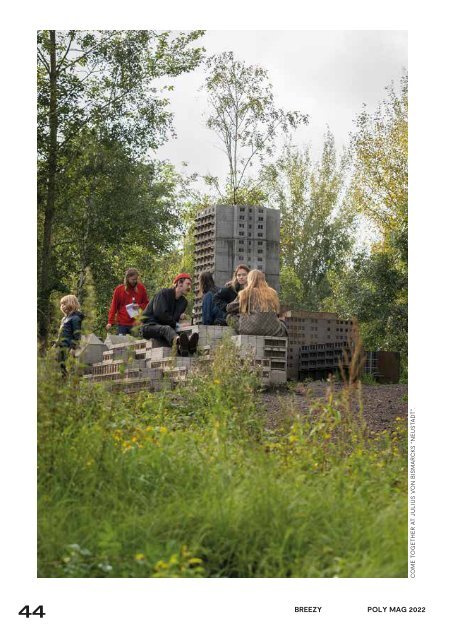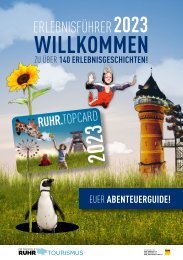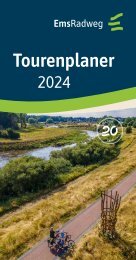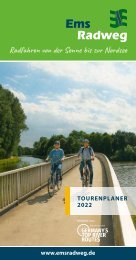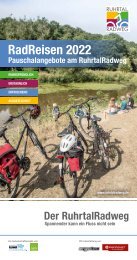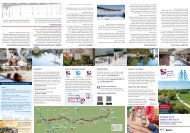Magazin „POLY“ - Free Guide 2022
Das englischsprachige Magazin „Poly“ führt durch das gesamte Ruhrgebiet und beleuchtet Kunst, Musik, Design und Gastronomie. Dazu gibt es Tipps, Empfehlungen und Einblicke in die kulturelle Landschaft der Metropole Ruhr. Magazine „POLY“ - Free Guide 2022 (english) One single city? No, lots of towns and cities. The Ruhrgebiet is often called "the city of cities". "Poly" will tell you how different they are and what they have in common. But most of all we want you to show you one thing: a constantly changing cultural scene and its transformative influence on the environment. For this is the motor behind new developments an radical changes. Poly leads through the Ruhr area and highlights art, music, design and gastronomy.
Das englischsprachige Magazin „Poly“ führt durch das gesamte Ruhrgebiet und beleuchtet Kunst, Musik, Design und Gastronomie. Dazu gibt es Tipps, Empfehlungen und Einblicke in die kulturelle Landschaft der Metropole Ruhr.
Magazine „POLY“ - Free Guide 2022 (english)
One single city? No, lots of towns and cities. The Ruhrgebiet is often called "the city of cities". "Poly" will tell you how different they are and what they have in common. But most of all we want you to show you one thing: a constantly changing cultural scene and its transformative influence on the environment. For this is the motor behind new developments an radical changes.
Poly leads through the Ruhr area and highlights art, music, design and gastronomy.
- No tags were found...
You also want an ePaper? Increase the reach of your titles
YUMPU automatically turns print PDFs into web optimized ePapers that Google loves.
COME TOGETHER AT JULIUS VON BISMARCKS “NEUSTADT”.<br />
In spring 2021 Julius von Bismarck and Marta<br />
Dyachenko planted miniature replicas of typical<br />
Ruhrgebiet architecture in the North Duisburg Landscape<br />
Park. They included a shabby department<br />
store, a neo-Gothic church, an apartment block<br />
and an indoor swimming pool with a chute. The<br />
project is an exciting new addition to the Emscher<br />
Art Trail, which is best explored by bike. The tiny<br />
buildings stand unobtrusively at the edge of the trail.<br />
It’s worth dismounting for a closer look because all<br />
the buildings – more than 20 in number – recreate<br />
architectural structures that have disappeared or<br />
been demolished in recent years and past decades.<br />
The effect is atmospheric and nostalgic.<br />
The tiny monuments – if we can call them<br />
that – have already started to rust in places and are<br />
visibly sinking into the greenery. Grass is growing<br />
around the Essen Adult Education Centre, and a<br />
buttercup in front of a 1960s tenement block in Marl<br />
stretches as high as the second-floor balcony. You<br />
might be forgiven for thinking of Sleeping Beauty,<br />
were it not for the fact that the Ruhr area has long<br />
since been revived. Culture and nature have replaced<br />
dirt and heavy industry, and this could also<br />
be the magic spell behind the Emscher Art Trail.<br />
This unique sculpture project tells us a lot<br />
about the region, its history and its little river, the<br />
Emscher. A century ago it was a cesspool, fed<br />
by the sewage from the Ruhr area. For decades<br />
it flowed along a deep concrete bed and was<br />
generally acknowledged to be the filthiest river in<br />
Germany. Today, after almost 30 years of renaturation,<br />
the picture is entirely different. The banks<br />
along the river are richly verdant. Chemicals and<br />
excrement have long disappeared from the water,<br />
reeds are growing and fish can swim in peace.<br />
Kingfishers have also been sighted.<br />
The Emscher Art project has been tied into<br />
this unprecedented clean-up since 2010. Artists<br />
have been coming here every three years. Many<br />
of their works have been temporary and disappeared<br />
again after a single summer. One prominent<br />
example was the thousand small tents that Ai Wei<br />
Wei set up on the riverbank. Other works have<br />
remained to populate the Emscher Art Trail, along<br />
with new additions in the coming years.<br />
From the small-scale replica buildings in the<br />
North Duisburg Landscape Park, it is only a few<br />
kilometres ride to the Kaisergarten in Oberhausen<br />
Each of the works on<br />
the Emscherkunstweg<br />
has been created<br />
especially for its<br />
particular location.<br />
where Tobias Rehberger’s spiral bridge – it consists<br />
of 496 aluminium arches – elegantly and effortlessly<br />
spans the Rhine-Herne Canal. The buoyant<br />
walkway winds back and forth over the canal on<br />
colourful plastic flooring and is intended to look<br />
like a rope being thrown over the water. Now it’s<br />
time to get back on your bike.<br />
The trail continues along the canal to a<br />
sculpture called the “Zauberlehrling”. You can see<br />
it from afar protruding over the tree tops in the<br />
middle of the Ripshorst woodland garden. It’s a<br />
pylon; but nothing like a regular electricity pylon,<br />
for it stands twisting and waving alone in a field.<br />
While all its many uniform counterparts in the<br />
vicinity are dutifully carrying their power cables<br />
on out-stretched arms, the “Zauberlehrling” has<br />
liberated himself. Perhaps he prefers to invest his<br />
energy elsewhere.<br />
If you go a little further back to the “sorcerer’s<br />
apprentice“ in Goethe’s poem, the sculpture created<br />
by a group called "Inges Idee" in 2013 could also<br />
be interpreted as a critical reference to the technical<br />
progress since the industrial revolution and its everincreasing<br />
consumption of natural resources. As<br />
Goethe wrote, “I shall never be able to rid myself of<br />
the spirits I have conjured up”. This might also be the<br />
case with regard to the future of our planet.<br />
The Emscherkunstweg is a cooperation<br />
between Urbane Künste Ruhr, Emschergenossenschaft<br />
and Regionalverband Ruhr, is supported<br />
by the Ministry for Culture and Science of the<br />
Federal State of North Rhine-Westphalia. It quickly<br />
becomes clear that this whole project is not about<br />
the harmonious coexistence of art and nature, as<br />
is so often the case with sculpture gardens, parks<br />
and trails. Each of the works on the Emscher Art<br />
Trail has been created especially for its particular<br />
location. They reflect and comment on the history<br />
and transformation of the Ruhr region in a variety<br />
of different ways.<br />
BREEZY<br />
POLY MAG <strong>2022</strong><br />
44<br />
POLY MAG <strong>2022</strong> BREEZY<br />
45


